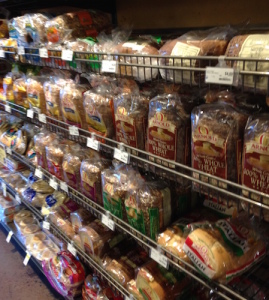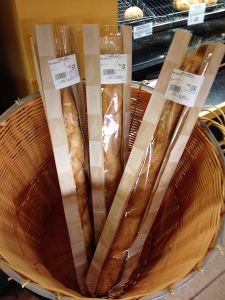This post was in anticipation of the January 28, 2015 (postponed from January 21) #breadchat on Twitter on the topic of storing bread. (Learn more about #breadchat: http://www.breadstorm.com/breadchat.html). The info has been taken from my book, Bread Science, which, incidentally, is now available as an ebook! (https://www.twobluebooks.com/ebooks/) There may be more recent research papers about staling; if you know of any, please share them.
Understanding staling is a good way to begin a discussion of bread storage. We think of stale bread as being dry, rock hard or too tough to chew, and/or flavorless. Scientists have described many aspects of staling; they occur at different rates so that bread might be stale in some ways but not others. The research is interesting to consider, but keep in mind that the research was often done with a goal of increasing the shelf-life of factory-made bread. For example, one study stored the bread in tin containers in a special cabinet [1], which might not be relevant to artisan bread stored on your counter.
Staling includes the following: [2,3,4]
- The crust becomes tough/chewy instead of crusty because moisture migrates from the middle of the bread outward to the atmosphere, via the crust.
- The bread becomes dry because of moisture migration.
- The crumb or inside of the bread becomes firm. This happens even when the bread is packaged so that moisture is retained; it is not simply the bread drying out. Firming is sometimes blamed on changes in the starch (see number 5), but this connection has been disputed; the cause of firming remains unknown.
- The bread loses flavor. This is because organic flavor molecules are lost to the atmosphere, deactivated, or altered in ways that affect flavor. The reappearance of some flavors on heating suggests that flavor compounds might become trapped in starch and released with heating. [5]
- The crumb becomes more white/opaque and firm due to starch retrogradation.
What is retrogradation? During baking, the starch in dough melts. The molecules become less organized and allow water molecules to move near them; some are partially dissolved. As the bread cools, the starch recrystallizes (retrogrades), going back to a solid form. This causes firmness. One part of the starch, amylose, retrogrades quickly, resulting in the original firmness of the bread. The other part, amylopectin, retrogrades more slowly, resulting in added firmness over the next few days. Some scientists link this with staling firmness and some do not. (Note: I find the concept of melting/solidifying starch a little confusing. Starch is [also?] absorbing water and gelating during baking. I don’t understand how these two concepts merge/overlap.)
How best to store your bread depends on how and when you plan to eat it. For example, a French baguette intended for that night’s family dinner would be best in a paper bag, which will maintain its crispy crust; but the same baguette will be rock hard in a day or two, so a plastic bag will keep it edible for a few days.
Temperature also affects staling: starch retrogradation happens faster at lower temperatures (i.e., in a refrigerator) but stops below freezing. Some aspects of staling can be reversed by heating: the starch crystals melt around 60°C (140°F), and the bread continues to soften up to about 100°C (~200°F), as shown in this plot: [1]
Here are some storage methods to consider:
- Paper bag. Bread will stay crusty but become firm and dry. There is no cure for dry bread. Use paper if crust is very important to you and you can eat the bread quickly.
- Plastic bag or container. Bread will retain its moisture but become chewy/tough and lose its crustiness. It can be softened and “re-crusted” in the oven (see below).
- Freezer. Bread can be stored a long time, and the re-crusting method (below) works to heat it for a dinner party. This bread also works as toast if you pre-slice it.
- Fridge. Bad!!!
To recreate (sort of) fresh-baked bread, keep your loaf (or some chunk of it) whole. Double-bag it and put it in the freezer. When you want to eat it, pull it out and defrost it completely; this may take a few hours depending on the room temperature. Heat the oven to 300°F. Put the naked loaf in (right on the oven rack) for ten minutes for a large loaf, less for smaller loaves. If the bread has been cut, cover the open side with foil to prevent the crumb from drying out. When you take the bread out, it will be crusty on the outside and soft in the middle, just like new. [6] Note that you can’t perform this magic repeated times, because the bread does get drier; it’s best to do this RIGHT before serving the bread.
I personally cannot eat a whole loaf before it stales, and I prefer to maintain the moisture of the bread rather than the crust. Therefore, my technique is this:
- Cut off what I think I can eat in 2-3 days.
- Put it in a plastic bag or Tupperware container.
- Slice the rest, put it in a plastic bag, and freeze it.
- Pull out frozen slices for toast as needed. A light toasting can defrost the bread without making it too crispy. Sometimes I let it defrost with time and then barely warm it in the toaster oven to make it softer.
[1] Bechtel, W.G., D.F. Meisner, and W.B. Bradley. “The effect of the crust on the staling of bread.” Cereal Chemistry 30 (1953) 160-168.
[2] “Bread and bakery products.” Foods and Food Production Encyclopedia. New York: Van Nostrand Reinhold Co., 1982 291-292.
[3] Hoseney, R.C. Principles of Cereal Science and Technology. St. Paul, Minnesota: American Association of Cereal Chemists, 1986 234-235.
[4] Kulp, K. “Baker’s yeast and sourdough in U.S. bread products.” Handbook of Dough Fermentation. New York, Basel: Marcel Dekker, Inc., 2003 132-133.
[5] Martinez-Anaya, M.A. “Enzymes and bread flavor.” Journal of Agricultural and Food Chemistry 44 (1996) 2469-2480.
[6] Update: I decided to do a taste test. Loaves A and B were sourdough boules. Loaves C and D were French demibaguettes. A and C were baked Monday, bagged and frozen, and defrosted Sunday morning; the crust was not at all crispy. Loaves B and D were baked Sunday morning. On Sunday evening, all four loaves were re-heated using the method described. When I sliced them, they all felt about the same. People were told that the breads were the same but had been stored differently and were asked, “Is one better?”
Sourdough: A = 1 vote, B = 7 votes, same = 2 votes; comments: A had a more sour flavor and thinner, crispier crust; B was more sour; B had a crisp crust
French: C = 3 votes, D = 5 votes; comments: D had a crispier crust; D was crustier
Obviously the test isn’t perfect, since the breads came from different batches of dough. Also, it would have been smarter to cut cubes of interior without crust, to assess the interior flavor alone. But the results seem to indicate that the frozen bread is pretty good, if not as good, as the new bread.





Thank you for sharing the article. It’s very interesting. Hope to hear more from you.
Thanks, George!
Thanks for sharing ! Question which is best polyethylene or polypropylene?
Polypropylene has a better water vapor barrier and polyethylene better oxigen barrier.
Hi Ricardo, I wasn’t sure I knew the difference so I started googling. Apparently the choice is very important in the world of comic book preservation!
For those out there like me who didn’t know, polyethylene (PE) bags are more flexible and translucent, whereas polypropylene (PP) is stiffer and crystal clear. There are pictures here: http://www.ipack.com/solutions/pe-pp/ There are different kinds of PE and PP, though; PE also includes those thin produce bags that come off a roll in the grocery store (aka LDPE #4).
My gut feeling was that preventing moisture escape would be more important than preventing oxygen transmission. Moisture escape has been implicated in staling, but as far as I know, oxygen transmission hasn’t. (I’m not sure how a bag’s oxygen transmission rate relates to its transmission rate of the organic flavor molecules that escape during staling.) But I don’t like to take a stand without data, so I googled more in the hopes of finding information directly about bread storage.
This just led to confusion. I found a lot of sites about plastic but none that directly address food/bread storage. The data seems conflicted, or maybe there are just many different kinds of PE/PP. For example, this webpage has a table that shows both PE (HDPE) and PP having high oxygen transmission rates: http://www.alphap.com/bottle-basics/plastics-comparison-chart.php
…whereas this webpage shows similar water permeation rates for PE and one kind of PP, higher rates for PE than the other PP types, and a higher oxygen permeation rate for PE than for all types of PP: http://www.multibriefs.com/briefs/exclusive/barrier_packaging_2.html
These were among the first sites that popped up, and I don’t know their context so comparing them might be like apples to oranges.
I wanted to try a taste test but could only find PE at the co-op. Has anyone else done one? In conclusion… I’d go with polypropylene but I wouldn’t bet the family fortune on it. (If there were a family fortune.)
In France in the Alps, people used to bake bread only once a year because of the scarcity of wood. All the village would gather around the fire wood oven, and bake the breads they had prepared. They stamped it in order to be able to recognize it when unloading the oven: bread stamp. And in order to be able to eat the bread baked a long time ago, they grated it: bread grate. I don’t know how they stored it, but it must have been wood or cloth, not plastic 🙂
Thanks for sharing this cool bit of history!
Pingback: Blogroll: Tasty chemistry : The Sceptical Chymist
Pingback: Eric’s Enlightenment for Friday, May 22, 2015 | The Chemical Statistician
Good research about Food Packaging Solutions, I prefer paper, but whatever choice you make has its pros and cons.